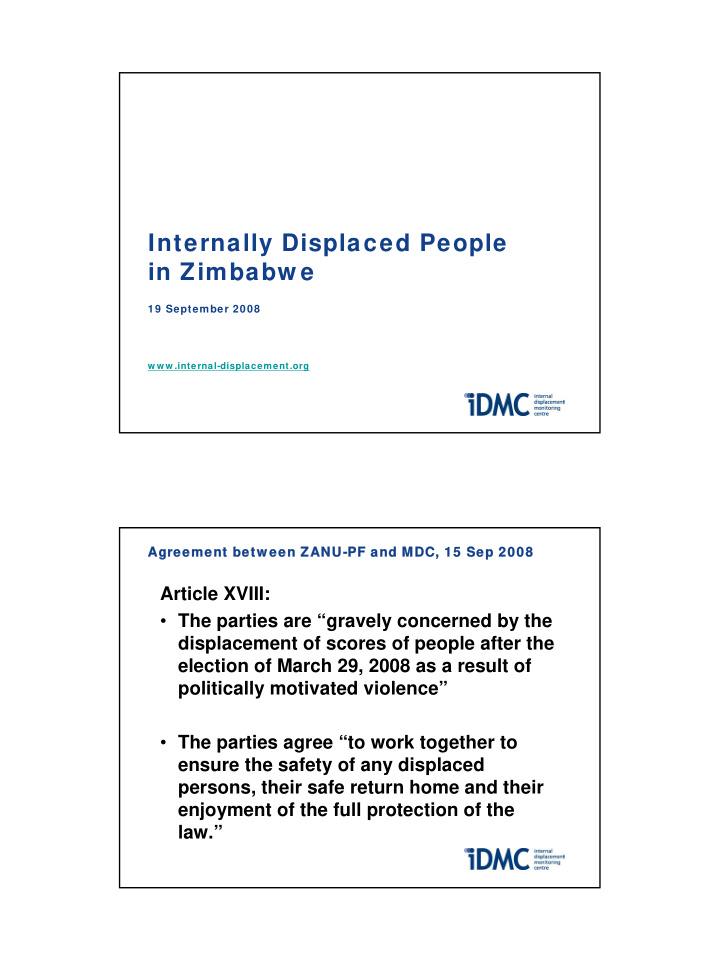



Internally Displaced People in Zimbabw e 19 September 2008 w w w .internal-displacement.org 1 Agreement betw een ZANU-P -PF and MDC, 15 Sep 2008 Article XVIII: • The parties are “gravely concerned by the displacement of scores of people after the election of March 29, 2008 as a result of politically motivated violence” • The parties agree “to work together to ensure the safety of any displaced persons, their safe return home and their enjoyment of the full protection of the law.” 2
Displacement caused by 2008 political violence Scale of displacement crisis: • MDC: 200,000 displaced people • UN: 36,000 displaced people Zimbabwe Peace Project (July 2008): • New cases of displacement after the June elections • Returnees are forced to pay a fine, “returnee’s fee” ( or “protection fee”, “registration fee”, “acceptance/clearance fee”) or perform community service 3 Agreement betw een ZANU-P -PF and MDC, 15 Sep 2008 Article XVI: • “In times of need, every Zimbabwean regardless of race, ethnicity, gender, political affiliation and religion is entitled to request and receive humanitarian and food assistance from the State.” • “In this regard the Parties hereby agree […] that all displaced persons shall be entitled to humanitarian and food assistance to enable them to return and settle in their original homes and that social welfare organisations shall be allowed to render such assistance as might be required.” 4
Humanitarian crisis in Zimbabw e • Life expectancy: 34 years (2005) (was 61 years during the early 1990s) • HIV/AIDS prevalence rate: 15.3% (5th highest in the world) • 1 million AIDS orphans (UNICEF) 5 Food deficits FAO/WFP (June 2008): • 2008: cereal deficit of 1.4 million MT • People dependent on food aid: • Jul-Sep 2008: 2 million people • Oct-Dec 2008: 3.8 million people • Jan-Mar 2009: 5.1 million people 6
UNICEF, Zimbabw e donor update, June 2007: : “The most acute humanitarian needs include those of populations affected by serious food insecurity, HIV and cholera outbreaks as well as those displaced during the fast-track land reform programme, Operation Murambatsvina (OM) and more recent re-evictions .” 7 IDPs in Zimbabw e • Former farm workers: victims of fast-track land reform programme (since 2000; ongoing) • Beneficiaries of land reform programme who have since been evicted again (more recent) • Victims of Operation Murambatsvina (May-July 2005; smaller-scale evictions ongoing) • Victims of Operation Chikorokoza Chapera (Nov 2006 – Jan 2007) • Politically motivated evictions (2008) 8
9 10
11 12
13 14
15 16
17 18
19 20
Scale of the displacement crisis � Operation Murambatsvina (2005): 570,000 people made homeless � Farm workers: 2 million people in 2000 (including seasonal workers and families) • < 2% have benefited from land reform programme • 10% still employed on the farms • 25-30% “displaced-in-place” 21 Multiple displacements “Floating population” of displaced people who have not been able to settle anywhere permanently � ZimVAC (June 2007): 8% of sampled population said they had been “asked to move” in the past five years ⇒ 1 million forcibly displaced people? 22
Lack of Durable Solutions • “Invisibly displaced”: urban overcrowding • Homeless people in urban areas • New illegal structures in urban areas • Squatters on government land • Squatters on farms (“displaced-in-place”) • Lack of tenure for beneficiaries of land reform programme ⇒ risk of new displacement / evictions 23
Recommend
More recommend